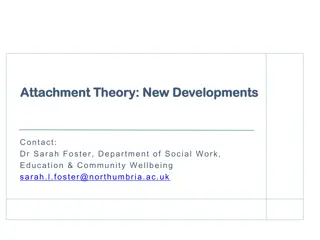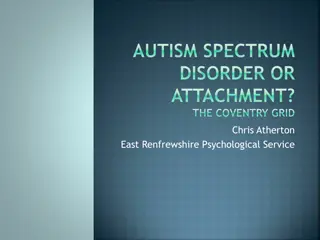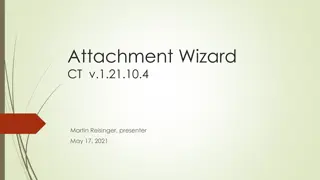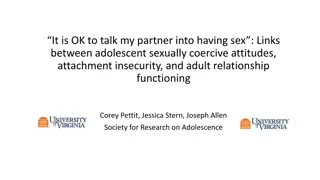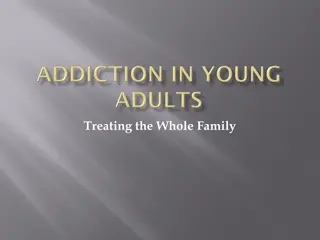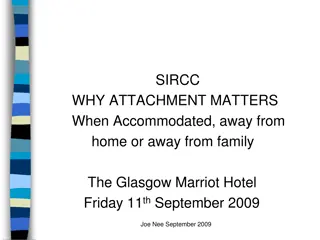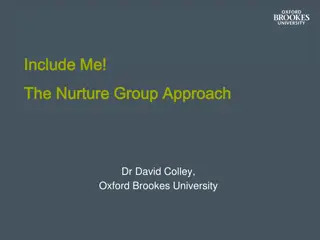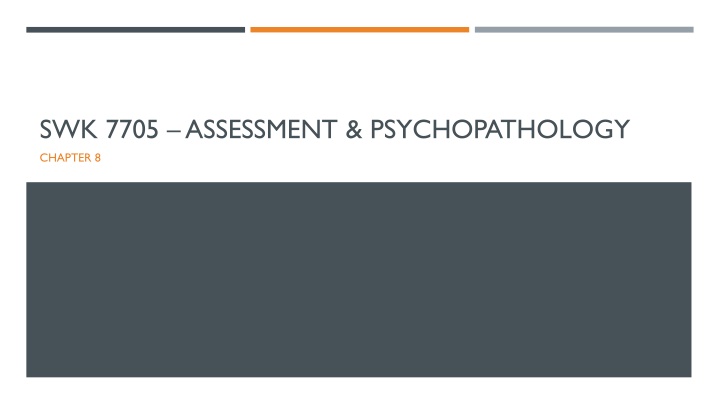
Trauma-Related Disorders in Children: RAD and DSED
Explore reactive attachment disorder (RAD) and disinhibited social engagement disorder (DSED), trauma-related disorders in children stemming from social neglect. Learn about their symptoms, impact, and underlying causes.
Download Presentation

Please find below an Image/Link to download the presentation.
The content on the website is provided AS IS for your information and personal use only. It may not be sold, licensed, or shared on other websites without obtaining consent from the author. If you encounter any issues during the download, it is possible that the publisher has removed the file from their server.
You are allowed to download the files provided on this website for personal or commercial use, subject to the condition that they are used lawfully. All files are the property of their respective owners.
The content on the website is provided AS IS for your information and personal use only. It may not be sold, licensed, or shared on other websites without obtaining consent from the author.
E N D
Presentation Transcript
SWK 7705 ASSESSMENT & PSYCHOPATHOLOGY CHAPTER 8
TRAUMA-AND STRESSOR-RELATED DISORDERS Characterizes those disorders where symptoms occur after exposure to a traumatic or stressful event Usually, some combination anxiety (internalizing symptoms) or anger (externalizing symptoms) is a part of the symptom picture Two disorders are included in this chapter that share a common etiology of social neglect - understood as the absence of adequate caregiving during childhood and they are: reactive attachment disorder and disinhibited social engagement disorder
REACTIVE ATTACHMENT DISORDER Characterizes a rare disorder found in children who lack attachments despite the developmental capacity to form them (sometimes known as attachment disorder) The core features of RAD disorder include failure to seek and respond to comforting when distressed - with social and emotional disturbances Seen with at least 2 of the following: minimal emotion regulation, reduced positive affect, and episodes unexplained fearfulness and anxiety children with a history of living in settings which limit attachment opportunities are at a higher risk Symptoms begin before the age of 5 - usually can be seen while still an infant - and must have a developmental age of at least 9 months Symptoms may lead to controlling, aggressive, or delinquent behaviors; trouble relating to peers The case of Annie Marozas in the text illustrates the symptom picture for RAD
DISINHIBITED SOCIAL ENGAGEMENT DISORDER (DSED) A disorder of a child s social relatedness - the central feature is that the child has experienced serious neglect or pathogenic care (such as severe parental neglect, abuse or mishandling) very early in life Behavior includes an inappropriate approach to unfamiliar adults, a lack of wariness of strangers, and a willingness to wander off with strangers Is not diagnosed before 9mth or after age 5 The child has experienced extremes of insufficient care that limits attachment opportunities Can persist into middle childhood and adolescence but has not been described in adults Prevalence estimated at approx. 20% in children placed in foster care or raised in institutions Jimmy John Clark illustrates in the text the symptom picture for DSED
POSTTRAUMATIC STRESS DISORDER (PTSD) Posttraumatic stress disorder (PTSD) is a psychiatric disorder that may occur in people who have experienced or witnessed a traumatic event such as a natural disaster, a serious accident, a terrorist act, war/combat, or rape or who have been threatened with death, sexual violence or serious injury (APA, 2020) PTSD has been known by many names in the past, such as shell shock during the years of World War I and combat fatigue after World War II, but PTSD does not just happen to combat veterans PTSD can occur in all people, of any ethnicity, nationality or culture, and at any age It affects approximately 3.5 percent of U.S. adults every year, and an estimated one in 11 people will be diagnosed with PTSD in their lifetime Women are twice as likely as men to have PTSD Three ethnic groups U.S. Latinos, African Americans, and American Indians are disproportionately affected and have higher rates of PTSD than non-Latino whites
POSTTRAUMATIC STRESS DISORDER (PTSD) Close exposure to the trauma seems to be a main aspect of developing PTSD - major reference points include the reaction to catastrophic events, such as: Witnessing a homicide or suicide Traffic accidents Combat Natural disasters Sexual assault Victimization (such as sexual molestation, robbery, aggravated assault) Survivors of holocausts Life events such as domestic violence or a diagnosis of HIV
POSTTRAUMATIC STRESS DISORDER (PTSD) It's normal to feel afraid during and after a traumatic situation (National Library of Medicine, 2021) The fear triggers a "fight-or-flight" response which is your body's way of helping to protect itself from possible harm; it causes changes in your body such as the release of certain hormones and increases in alertness, blood pressure, heart rate, and breathing In time, most people recover from this naturally, but people with PTSD do not feel better; they feel stressed and frightened long after the trauma is over In some cases, the PTSD symptoms may start later on or come and go over time Researchers do not know why some people get PTSD and others do not; genetics, neurobiology, risk factors, and personal factors may affect whether you get PTSD after a traumatic event
POSTTRAUMATIC STRESS DISORDER (PTSD) Who is at risk for post-traumatic stress disorder (PTSD)? (National Library of Medicine, 2021) You can develop PTSD at any age. Many risk factors play a part in whether you will develop PTSD. They include: Your sex; women are more likely to develop PTSD Having had trauma in childhood Feeling horror, helplessness, or extreme fear Going through a traumatic event that lasts a long time Having little or no social support after the event Dealing with extra stress after the event, such as loss of a loved one, pain and injury, or loss of a job or home Having a history of mental illness or substance use
PTSD SYMPTOM PICTURE The central feature of PTSD is exposure to actual or threatened death, serious injury or sexual violence exposure does not include events seen only in electronic media, television, movies or pictures Sexual assault and combat experiences are the most common traumas associated with PTSD Other examples of tragedy that can cause PTSD include events like those from 9/11 which showed that PTSD not only impacts those affected but their families, significant others, those who witnessed the event, first responders, and society as a whole Symptoms must last for more than one month and significantly affect important interpersonal areas of the person s life such as family interaction and employment PTSD is not reflective of another medical condition or the effects of a substance such as medication or alcohol
PTSD SYMPTOM PICTURE CONTINUED Next, the practitioner considers 4 symptom clusters characterized as follows (note the diagnostic thresholds of PTSD for children 6 years of age and younger): Re-experiencing the event - One or more of the following intrusion symptoms associated with the traumatic event(s) of (1) spontaneous memories of the traumatic event (Note: Children older than 6 years of age may engage in repetitive play showing themes of the trauma.); (2) recurrent dreams related to it (Note: Children may have frightening dreams where the content is vague or indistinguishable.); (3) flashbacks (Note: Children may reenact trauma through play.); (4) other intense or prolonged psychological distress; or/and (5) marked physiological reactions Avoidance - One or both of the following (1) distressing memories, thoughts, feelings or external reminders of the event; and (2) efforts to avoid external reminders that provoke distressing memories thoughts or feelings associated with the traumatic event(s)
PTSD SYMPTOM CLUSTERS CONTINUED Negative thoughts and mood or feelings Two or more of the following (1) an inability to remember key aspects of the event; (2) negative thoughts about oneself, others, or the world such as I am bad, or No one can be trusted. ; (3) feelings that may vary from a persistent and distorted sense of blame of self or others; (4) a persistent negative emotional state such as fear, horror, anger guilt or shame; (5) a markedly diminished interest in activities to estrangement from others; (6) feelings of detachment or estrangement from others; or/and (7) to an inability to experience positive emotions such as happiness or loving feelings Heightened arousal -As seen by two or more of the following (1) aggressive angry outbursts; (2) reckless or self-destructive behavior; (3) hypervigilance; (4) exaggerated startle response; (5) problems concentrating; or/and (6) sleep disturbances
PTSD SPECIFIERS Those exposed to a traumatic event may not exhibit PTSD features until years afterward specify with delayed expression This is if the full diagnostic criteria are not met until at least 6 months after the event (although the onset and expression of some symptoms may be immediate) The person may also experience dissociative symptoms specify with dissociative symptoms This is when the individual s symptoms meet the criteria for POST, and the individual experiences persistent or recurrent symptoms of either of the following: Depersonalization: persistent or recurrent experiences of feeling detached from and as if one were an outside observer of one s mental processes or body Derealization: persistent or recurrent experiences of unreality of surroundings The case of Buddy Jackson in the texts illustrates someone who experienced a delayed onset of PTSD
ACUTE STRESS DISORDER (ASD) ASD looks a lot like PTSD but emphasizes the severe reaction that some people have within the first month immediately following a trauma ---ASD includes any 9 of 14 symptoms in the following categories: Intrusion As seen by: (a) recurrent, involuntary, and intrusive distressing memories of the traumatic event(s) (Note: Children may engage in repetitive play where themes or aspects of traumatic event(s) are communicated.) (b) the content and/or affect of recurrent, distressing dreams related to traumatic event(s); (c) dissociative reactions such as flashbacks and these reactions can range on a continuum with the most extreme reaction being a complete loss of awareness of one s surroundings (Note: Children may reenact trauma-specific themes in play.); (d) intense or prolonged reactions (either psychological or physiological) in response to cues that resemble (or may symbolize) an aspect of the traumatic event(s) Negative mood Persistent inability to experience positive emotions such as happiness, satisfaction or loving feelings
ASD SYMPTOM CATEGORIES CONTINUED Dissociation Understood as (a) an altered sense of reality of one s surroundings or oneself much like being in a daze or time has slowed or seeing oneself from another s perspective, or (b) being unable to remember important features of the traumatic event(s) and typically not due to dissociative amnesia or a head injury, alcohol or drug use Avoidance Considered to be (a) efforts to avoid distressing memories, thoughts or feeling about (or closely associated with) the traumatic event(s), and (b) trying to avoid external reminders such as avoiding people, ;laces, conversations, activities or situations that provoke distressing memories, thoughts or feelings about (or closely associated with) the traumatic event(s) Arousal Regarded as (a) sleep disturbances, (b) irritability or angry outbursts typically seen as verbal or physical aggression toward others or objects, (c) hypervigilance, (d) difficulty concentrating, (e) an exaggerated startle response The following case of Louise Ann Brown in the text illustrates acute stress disorder
THE ADJUSTMENT DISORDERS Adjustment disorders generally occur as a reaction to a life-threatening event and tend to last longer - assessing for adjustment disorders includes: Distress is out of proportion to the severity or intensity of the stressor(s) Once the stressor or its consequences have ended, symptoms do not persist for more than an additional 6 months Consider 6 of the following specifiers: With depressed mood low mood, tearfulness, or feelings of hopelessness are prevalent; With anxiety nervousness, worry, jitteriness, or separation anxiety are predominant; With mixed anxiety and depressed mood a combination of depression and anxiety; With disturbance of conduct when disturbed conduct is predominant; With mixed disturbance of emotions and conduct both emotional symptoms (such as depression, anxiety) and a disturbance of conduct are present; and Unspecified for maladaptive reactions that are not seen as one of the specific subtypes of adjustment disorder Jeannette Hutton in the text illustrates symptoms of an adjustment disorder
Differences between AD & PTSD (Brown, 2019) Stressor: common stressors in AD are changes in life events that are significant such as sickness, unemployment, and moving; PTSD triggers are more serious events related to sexual violence, serious injury, etc. Duration: AD manifests w/in 3 months of onset and should not last more than 6 months whereas PTSD symptoms last for more than a month and delayed expression can occur Symptoms: AD symptoms are less intense and not as frequent; PTSD symptoms are more intense, intrusive, and distressing http://www.differencebetween.net/science/health/difference- between-adjustment-disorder-and-ptsd/
OTHER SPECIFIED (AND UNSPECIFIED) TRAUMA- AND STRESSOR- RELATED DISORDERS Specified trauma- and stressor-related disorder - applies when the person s symptom picture does not meet full criteria for any of the disorders in this chapter The practitioner can communicate the reason the person s symptom presentation does not meet criteria; some examples are included in the text Unspecified trauma- and stressor-related disorder - applies to those who present with symptoms characteristic of a trauma- and stressor-related disorder and used in situations when the practitioner elects not to specify the reason that diagnostic criteria
COMPARING THE DSM-IV-TR MULTIAXIAL SYSTEM AND THE DSM-5 Obsessive-compulsive and related disorders is a new DSM-5 chapter which includes 4 new disorders - hoarding disorder, excoriation (skin-picking) disorder, substance/medication-induced obsessive-compulsive and related disorder, and obsessive-compulsive and related disorder due to another medical condition Trichotillomania (hair-pulling disorder) was moved from impulse-control disorders not elsewhere classified in the DSM-IV to the DSM-5 classification as an obsessive-compulsive disorder A specifier was expanded and added to body dysmorphic disorder and hoarding disorder- good or fair insight, poor insight, and absent insight/delusional (or when the person is convinced that the obsessive- compulsive disordered beliefs are true) Criteria were added to body dysmorphic disorder to describe repetitive behaviors or mental acts that may surface with perceived defects of flaws in physical appearance The specifier with obsessive-compulsive symptoms moved from the anxiety disorders to the DSM-5 category of obsessive-compulsive and related disorders Two additional diagnoses - (1) other specified obsessive-compulsive and related disorder which applies when diagnostic criteria are not met but the practitioner can stipulate reasons why, and (2) unspecified obsessive-compulsive and related disorder used when there is insufficient information to make a diagnosis


